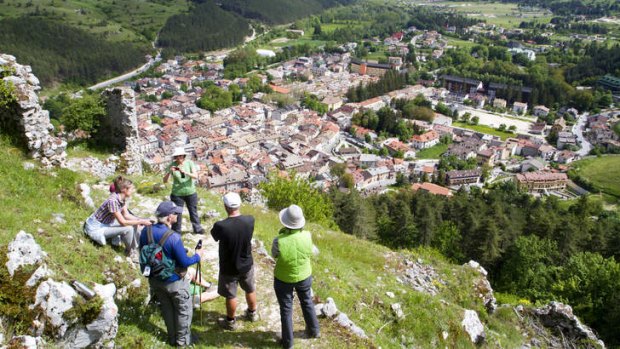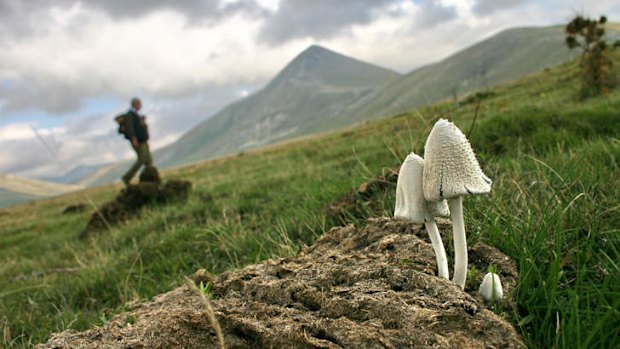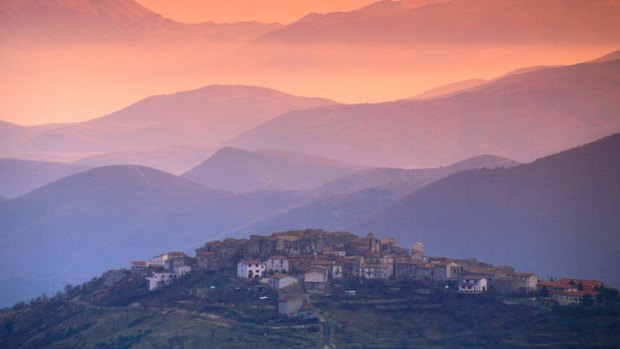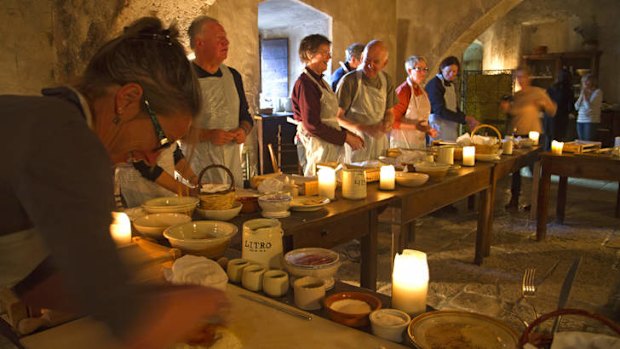
Overlooking Pescasseroli.Credit: Andrew Bain
Hiking the hills of Abruzzo is a stroll through a fine menu, writes Andrew Bain.
Around the Italian town of Sulmona, the fields and valleys are smothered in poppies, creating a virtual Red Sea that's parted by the road and framed by mountains. It's a suitably bright entrance to a town known to many in Italy for one thing only: brilliantly coloured sugared almonds.
Wander Sulmona's main street and the sugared almonds - known locally as confetti - are everywhere, filling store windows and lining the cobblestones. They form the shapes of insects, ducks and umbrellas, but most typically they're arranged into flowers, with a sugared almond for each petal. It's like walking through an edible forest.

Wild mushrooms in Abruzzo.Credit: Getty Images
Sulmona's confetti is arguably the most famous food item in the Italian region of Abruzzo, but also perhaps its least typical. Rising above the town are the craggy mountains of the central Apennines and it's up here that Abruzzo's true flavours and flowers are found.
In Italy, people talk a lot about the north-south divide, but Abruzzo is neither. Just two hours' drive east of Rome, it's Italy's wild heart, a place that's long been a world apart, first through poverty and now through the rugged nature of its landscape.
Two-thirds of the little-visited region, which claims to be the greenest in Europe, is mountainous, and it's protected by more national parks - than any other region in the country. Bears and wolves roam its mountains, which are the highest in Italy outside the Alps.

Sunset over Abruzzo mountains.Credit: Alamy
It's a region best seen on foot and I've come to hike, which is really an excuse to eat. Abruzzo's food is as undiscovered as its lands, with the region's historical isolation reflected in its cuisine, which is far from typically Italian.
Up here, the dishes have a simplicity that reflects the harsh mountain conditions and hilltop villages harbour small family owned restaurants that remain true to the cucina povera - "cooking of the poor" - of Abruzzese tradition.
Hiking in Abruzzo, I sense the connection between land and plate more than in most other places I've walked. The soil you hike on is the soil that feeds you, as is apparent from the moment we begin walking in Gran Sasso e Monti della Laga National Park.

A cooking class at Santo Stefano.
On the slopes of the Gran Sasso, Campo Imperatore is the ultimate case in point. About 25 kilometres in length and ranging in altitude from 1600 to 2300 metres, it's the largest alpine plain in Italy. To hike
here is to walk in the hoof prints of millions of sheep. For centuries, Campo Imperatore has been a summer grazing ground and the start of the epic transumanza, the three-week march by shepherds and their flocks to the plains of Puglia at the end of summer.
Nearby, the village of Santo Stefano di Sessanio is one of only three Slow Food Presidia in Abruzzo, said to be producing the finest lentils in Italy. Continue down and you come to the Navelli Plain, famed for its saffron, which is touted as the best in the world.
Locally, the saffron and ewe's milk make their way into cheeses and the lentils will add bulk and flavour to almost every soup I eat during the coming week. Lamb rules every menu. Wild spinach from the alpine plains fills side dishes in even the finest local restaurants. What I'm doing out on Campo Imperatore is essentially strolling through the menu.
The plain at Campo Imperatore is almost trackless, but then it's also entirely treeless, making navigation simple. Through the morning, we wander across lonely, wildflower-covered lands made even lonelier by the icy winds. A mob of wild horses rises over a ridge, moving like the shadow of a cloud, and the ruins of a chapel used by early shepherds sit crumbled in the distant crook of a pass.
As the wind funnels through a narrow break in the hills, we climb to the head of a valley, where our van and lunch await. A table is spread with breads, salamis, pomodoro and a vegetable and lentil soup. The tablecloth snaps in the wind and rain showers scud across the nearby mountaintops.
As I nibble on ciabatta and olive paste, with a glass of montepulciano d'Abruzzo, the region's trademark red wine, at my feet, the scene feels so unreal that it's like being inside an absurdist painting.
As the week progresses, we work our way south through Abruzzo, passing from national park to national park, the days flitting between mountains and meals.
In Majella National Park, we climb through the Bosco di Sant'Antonio, a section of beech forest revered even by the Romans: the forest was once considered so sacred that it was forbidden to cut down any of its trees. Our base inside Majella National Park is the town of Pescocostanzo. Noted for its gold filigree production and its fine renaissance and baroque architecture, it has long been, by Abruzzese standards, an affluent town.
Snow is sifting into Pescocostanzo as we enter, though summer is now less than a week away. Along the main street, jewellers share space with a smattering of restaurants and, after four days of walking, it's the latter that feels like the town's true treasure.
In the centre of town, Ristorante da Paolino is one of the area's most celebrated restaurants. With a rustic-chic interior (erring more towards rustic), and run by two brothers and their mother, it prides itself on traditional Abruzzese cuisine.
This night the meal begins with rough-cut pasta with veal ragout, truffles, pecorino (ewe's milk cheese) and mushrooms. The next morning we'll walk past locals picking the mushrooms on the slopes of a nearby range. It's followed by rabbit with orange and wild picked herbs and the now-customary plate of orapi, the wild spinach that's endemic to the high slopes of Abruzzo.
Our final days of walking are in the Abruzzo, Lazio and Molise National Park, which straddles the borders of three regions. Italy's oldest national park, it was established in 1922 and is best known as the final stronghold of the Marsican bear, a subspecies of the European brown bear. Only 30 to 40 bears are thought to remain in the wild, although their images seem to grace every tourist building in every town.
Through the Fondillo Valley, we hike along an ancient path skirting the edge of beech woodland, rising slowly up a ridge that looks out onto a snowy rim of mountains. Cuckoos chime from the trees and cowbells sound from the valleys, which are carpeted with buttercups. It's an alpine scene, 500 kilometres from the Alps.
Crowning the ridge is the thin- as-sticks village of Opi, its terracotta homes looking like serrations in the ridge top. Other houses sit huddled in the valley immediately below, as though parts of the village have slipped.
We lunch in a small restaurant below Opi and walk on towards Pescasseroli, the town at the heart of the national park, hiking along a broad ridge as open and green as a links golf course.
Compared with the towns we've walked through until now, Pescasseroli is a virtual metropolis, yet at its edge is the most agrarian of scenes. In an iron shed surrounded by a pair of old caravans and his flock of goats, Giuseppe Tarquinio creates fine cheeses that will be sold in his wife's store, the Bottega del Formaggio.
On our first morning in Pescasseroli, we walk through the town and across the valley to Giuseppe's shed. The snowy flanks of Monte Marsicano, the park's second-highest peak, rise above, and Giuseppe makes the goat's milk cheese as we watch, separating the curds from the whey almost as quickly as he talks.
"Making cheese is a passion
I've had all my life," he says. "When I was a boy, I used to go out with the shepherds.
"Cheese is like wine. It has to live. Buy it from a supermarket and it's all the same. It needs to be natural."
As the national park's geographic hub, Pescasseroli offers many walking options. One day we'll climb a spur to Mancino Castle, a ninth-century ruin built on such a slope that it looks almost to be avalanching into the valley. Another day we'll hike in howling winds, snow and sleet across one of the exposed ridges that encircle the town.
But as all the signs and posters suggest, it's the Marsican bear that's the star feature of this park. And word has come of bear sightings in recent nights in a valley about 12 kilometres from Pescasseroli.
In the evening we drive out to the tiny village of Gioia Vecchio. Once home to 2000 people, Gioia Vecchio was all but destroyed by an earthquake in 1915. Today few people live here - most of the village was relocated into a lower valley - but in a car park behind the rebuilt church we stand at a cliff edge, peering down into a shallow green valley, considered to be the national park's most reliable spot to sight bears.
In late autumn and early summer, bears come to this valley to mate and graze on a particular grass that grows here. The last few nights, a limping sow has been seen wandering through its clearings.
High above the valley, we wait and watch. Evening slides towards night and the only movement is a few horses and a lone grazing deer. There are no bears in sight, but all is not lost, for dinner awaits.
The writer travelled courtesy of Hedonistic Hiking.
TRIP NOTES
GETTING THERE
Emirates has a fare to Rome for about $1610 low season from Melbourne and Sydney including taxes. Fly to Dubai (about 14hr) and then Rome (6hr 30min); see emirates.com. Santo Stefano di Sessanio is about two hours' drive inland from Rome. ARPA buses run from Rome Tiburtina. See arpaonline.it/arpaonline/en).
HIKING THERE
Hedonistic Hiking has a nine-day Wilds of Abruzzo trip (€2595; $3800) that spends three nights in Sextantio Albergo Diffuso. See hedonistichiking.com.au.
MORE INFORMATION italia.it/en.
FIVE MORE FOOD WALKS IN ITALY
AMALFI COAST
The Campania region means pizza and the hilly Amalfi terrain will certainly walk up an appetite. The most popular trail is the three-hour Sentiero degli Dei from Positano to hilltop Agerola.
CINQUE TERRE
A famous hike between the Cinque Terre's five villages, grazing as you go.
CHIANTI
Even the name can make you thirsty, and the Monti del Chianti hills are a popular walking area, with plenty of chances for great food and wine.
ANELLO DEL RINASCIMENTO
The so-called Renaissance Ring runs a 170-kilometre circle around Florence. Public transport connects each section to the city for an end-of-day Tuscan feast.
TOUR DU MONT BLANC
Arguably Europe's most famous hike, the TMB's Italian section cuts through the Valle d'Aosta, with its fontina cheese and solid, hearty fare. Base yourself in Courmayeur and explore the trails and the Aostan cuisine.
Sign up for the Traveller Deals newsletter
Get exclusive travel deals delivered straight to your inbox. Sign up now.